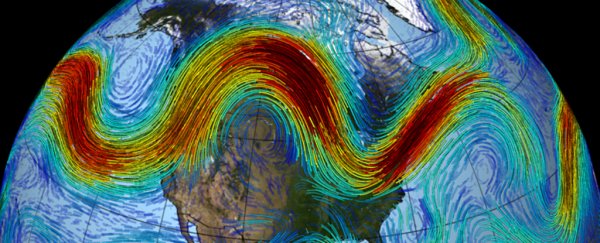Scientists have shed new light on how crazy weather extremes can be caused by jet stream 'traffic jams' – high-altitude backlogs of air that apparently work a little like how cars slow down your peak hour trip to the office every morning.
Crucially, understanding how these currents become backed up could help us work out how the planet's climate is going to evolve over the next few years and decades.
We've known for a while that when the air in a fast-flowing jet stream slows down, hurricanes or heatwaves can be the result.
The new maths model proposed by researchers from the University of Chicago explains why this blocking of air currents might happen, and how climate change can affect it.
"Blocking is notoriously difficult to forecast, in large part because there was no compelling theory about when it forms and why," says one of the team, Noboru Nakamura.
Nakamura and his colleague Clare S. Y. Huang looked closely at the data we have on jet streams, tracking the meandering movement of these passages of air high up in the atmosphere, and found a match with another pattern already recorded – one related to traffic jams.
It seems jet streams have a certain capacity in the same way that a motorway does. Once that capacity is reached, everything slows down or stalls, explain the researchers – so the air currents have to put on the brakes.
"It turns out the jet stream has a capacity for 'weather traffic', just as [a] highway has traffic capacity, and when it is exceeded, blocking manifests as congestion," says Huang.
The researchers found that congestion can happen when jet streams are slowed up by mountains or coasts, and when several air currents converge, just like when different highways converge and traffic must merge into fewer lanes.
Not only does this mathematical model fit with the pattern of blocking in recent major meteorological events, it can actually predict future high-altitude traffic jams – and that could help scientists get a handle on which areas are most at risk from flooding or drought in the years to come.
Jet streams, capable of travelling as fast as 400 kilometres-per-hour (250 miles-per-hour), actually act like highways for weather fronts. If the jet stream gets congested, that has a knock-on effect on everything else.
In general, the model shows more blocking occurring as the planet gets warmer, but there will be regional differences: the Pacific Ocean may see a decrease in blocking over the next few decades, for example.
Part of the beauty of this new model is its relative simplicity – something which makes it stand out in a field of otherwise incredibly complex and detailed calculations designed to predict the weather.
"It's very difficult to forecast anything until you understand why it's happening, so this mechanistic model should be extremely helpful," says Nakamura.
The research has been published in Science.
